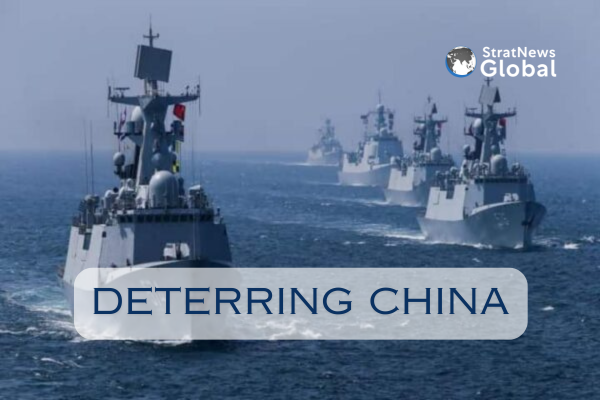There’s a churn underway in East Asia and this is not just about Chinese naval vessels steaming through the South China Sea in their campaign of intimidation and land-and-sea grabbing. It’s about long-time treaty allies seeking to step up their relationship at a time when the seas around them are under increasing threat from China.
On April 10, President Biden hosted Japan’s Prime Minister Fumio Kishida at the White House, where the two leaders made some historic announcements and unveiled more than 70 programmes and initiatives.
“This visit is historic,” says Dr Satoru Nagao, non-resident scholar at the Hudson Institute, “since Japan is now a security provider in the region.”
Speaking to The Gist on Stratnews Global, he noted that the role of security provider is a far cry from the traditional suspicion with which Tokyo is viewed in southeast and northeast Asia, given its history of colonial subjugation, wars and large scale killing of civilians. But times are a changing and the increasing threat from China has much to do with it.
The Biden-Kishida summit earlier this month seeks to give new strength to what is an old alliance that goes back to the end of World War II. It calls for an integrated headquarters in Tokyo that will ensure seamless cooperation between the Japanese military high command and the US. In effect, command and control structures are being modernised and interoperability and joint planning are moving forward.
Dr Satoru pointed to some other developments: a networked system of air, missile and defence architecture, a proposed trilateral military drill with the US, UK and Japan and within the AUKUS, how Japan could contribute in areas like AI and autonomous systems.
The US has designated a four-star general who will be based in the Japanese capital and is on par with the commanders of Central and Indo-Pacific Commands, Dr Satoru noted. It gives the US and Japan flexibility in the event of an operational commitment.
On the flip side, China’s ambitions of controlling the East and South China Seas in the event it decides to invade Taiwan, now have an obstacle before them. While the Chinese Navy’s fleet expansion is rapid, it remains an untried and untested force. Until now it only had the US Navy to contend with, but given the steady expansion of the Japanese Navy with new ships and submarines, and aircraft of various kinds, the Chinese may no longer have the kind of free run they had in those seas.
There is an issue in the widening gap, in terms of numbers, between the Japanese military and that of China’s. The former numbers 150 ships of all kinds whereas the Chinese have deployed 370 vessels, which could rise to 400 by next year. They are also gaining experience operating in distant waters. China has alsdo avoided any situation that could precipitate a conflict with the US, preferring to act by stealth, occupying territory when the world is distracted by other developments, Dr Satoru said.
Its history of occupying islands in the South China Sea is testimony that China would prefer such stealth actions. It tries to take advantage of any power vacuum. It’s also easier to intimidate and bully smaller countries that are its neighbours in the South China Sea.
The Philippines is the other element in this chain, it’s an old ally of the US, they did fall apart for some time but now seem to be getting back under President Marcos. The three countries together hope to improve the odds against China through joint patrols in the Indo-Pacific.
Although the Philippines military has long been derided as ramshackle, there’s no doubt that under Marcos a major effort is underway to improve its capability at sea and in the air where the major threat from China comes from. Dr Satoru noted India’s supply of Brahmos cruise missiles and Manila exploring other purchases.
“We should not forget that this is an effort to deter war. Philippines believes that war is not near because deterrence is improving, deterrence based on the stimulation of the war,” Dr Satoru said. “We are trying to deter war but the risk exists, yes.”
Could South Korea join this trilateral alliance to make it another Quad? Perhaps but Dr Satoru believes Seoul is fixated on North Korea and its constant sabre rattling. But South Korea has a good military industry and can contribute. It hopes to sell its new indigenous fighter jet to Manila and has already sold the K-9 Vajra self-propelled artillery to India with local production also taking place.
A word about India: China sees rising India as a threat and it accounts for the provoking it does along the Line of Actual Control. China senses India as a rival to its ambitions in Asia. While India’s profile as a security provider is growing, India and Japan can do more together, says Dr Satoru. The exercises going on between the two armies, navies and air forces also send a message to China.
India has also gradually shifted away from its One China policy, and moved closer to Taiwan, increasing the level of diplomatic representation. The point being made is Beijing should reciprocate with a One India policy and cease making claims on Indian territory.
Clearly, China’s aggression is creating new coalitions in the seas it claims as its own. The provocations against India point to more fronts being opened, which doesn’t make strategic sense. Does China believe it has won without firing a shot? The turbulence on the ground suggests otherwise.
Thirty eight years in journalism, widely travelled, history buff with a preference for Old Monk Rum. Current interest/focus spans China, Technology and Trade. Recent reads: Steven Colls Directorate S and Alexander Frater's Chasing the Monsoon. Netflix/Prime video junkie. Loves animal videos on Facebook. Reluctant tweeter.





